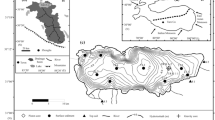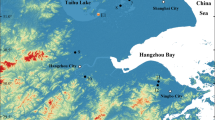Abstract
The Eocene palaeovegetation landscape and palaeoclimate reconstructed from the pollen records in the Jiuquan Basin, northwest China provide some important information on the early uplift of the Tibetan Plateau and the origin and evolution of the aridification in northwest China. The records show the arid-semiarid scrubs with open forest palynofloras controlled by the subtropical high existed in northwest China during the 40.2–33.4 Ma. Four pollen assemblages are found: Nitrariadites-Cheno-podipollis-Pinaceae assemblage (40.2–37.9 Ma) is followed by Chenopodipollis-Nitrariadites assemblage (37.9–34.6 Ma), Pinuspollenites & Abietineaepollenites-Chenopodipollis assemblage (34.6–33.9 Ma), and Chenopodipollis-Nitrariadites assemblage (33.9–33.4 Ma). The percentage of thermophilic types is in anti-correlation with that of the dry types, which means the palaeoclimate is relatively warm-wet or cold-dry during most of that time. Such aridity may be related to the water vapor reduction and the planetary wind system movement northward in response to the cooling caused by small-ephemeral ice-sheets.
Similar content being viewed by others
References
Zachos J C, Pagani M, Sloan L, et a1. Trends, rhythms, and aberrations in global climate 65 Ma to present. Science, 2001, 292: 686–693
Lear C H, Rosenthal Y, Coxall H K, et al. Late Eocene to early Miocene ice sheet dynamics and the global carbon cycle. Paleoceanography, 2004, 19(4): 1029–1039
Tripati A, Backman J, Elderfield H. Eocene bipolar glaciation associated with global carbon cycle changes. Nature, 2005, 436: 341–346
Bohaty S M, Zachos J C. Significant Southern Ocean warming event in the late middle Eocene. Geology, 2003, 31: 1017–1020
Chen L X, Liu J P, Zhou X J, et al. Impact of uplift of the Qinghai-**zang Plateau and change of land-ocean distribution on the climate over Asia. Quat Sci (in Chinese), 1999, (4): 314–329
Zhao J. Chinese Physical Geography (in Chinese). 3rd ed. Bei**g: Higher Education Press, 1997
Manabe S, Terpstra T B. The effects of mountains on the general circulation of the atmosphere as identified by numerical experiments. J Atmos Sci, 1974, 31: 3–42
Kutzbach J E, Guetter P J, Ruddiman W F, et al. Sensitivity of climate to late Cenozoic uplift in Southern Asia and the American West: Numerical experiments. J Geophys Res, 1989, 94(D15): 18393–18407
Liu T S. Loess and Environment (in Chinese). Bei**g: Science Press, 1985
An Z S, Kutzbach J E, Prell S C. Evolution of Asian monsoons and phrased uplift of the Himalaya-Tibetan Plateau since Late Miocene times. Nature, 2001, 411: 62–66
Ding Z L, **ong X F, Sun J M, et al. Pedostraigraphy and paleomagnetism of a 7.0 Ma eolian loess-red clay sequence at Lingtai, Loess Plateau, north-central China and the implications for paleomosoon evolution. Palaeogeogr Palaeoclimatol Palaeoecol, 1999, 152: 49–66
Li J J, Fang X M. Uplift of the Tibetan Plateau and environmental changes. Chin Sci Bull, 1999, 44(23): 2117–2124
Guo Z T, Ruddiman W F, Hao Q Z, et al. Onset of Asian desertification by 22 Myr ago inferred from loess deposits in China. Nature, 2002, 416: 159–163
Wang P X, Clemens S, Beaufort L, et al. Evolution and variability of the Asian monsoon system: Sate of the art and outstanding issues. Quat Sci Rev, 2005, 24: 595–629
An Z S, Zhang P, Wang E Q, et al. Changes of the monsoon-arid environment in China and growth of the Tibetan Plateau since the Miocene. Quat Sci (in Chinese), 2006, 26(35): 678–693
Liu T S, Zheng M P, Guo Z T. Initation and evolution of the Asian monsoon system timely coupled with the ice-sheet growth and the tectonic movements in Asia. Quat Sci (in Chinese), 1998, 3: 194–204
Guo Z T, Peng S Z, Hao Q Z, et al. Late tertiary development of aridification in northwestern China: Link with the Arctic ice-sheet formation and Tibetan uplifts. Quat Sci (in Chinese), 1999, (6): 556–567
Song Z, Li W, He C. Cretaceous and Palaeogene palynofloras and distribution of organic rock in China. Sci Sin B (in Chinese), 1983, 26(5): 538–549
Li X Z, Dong G R, ** H L. Discovery of dune sandstones of Cretaceous in Ordos Basin. Chin Sci Bull, 1999, 44(8): 874–877
Dai S, Fang X M, Song C H, et al. Early tectonic uplift of the northern Tibetan Plateau. Chin Sci Bull, 2005, 50(15): 1642–1652
Zachos J C, Quinn T M, Salamy K A. High-resolution (104 years) deep-sea foraminiferal stable isotope records of the Eocene-Oligocene climate transition. Paleoceanography, 1996, 11: 251–266
Miller K G, Fairbanks R G, Mountain G S. Tertiary oxygen isotope synthesis, sea level history, and continental margin erosion. Paleoceanography, 1997, 2: 1–19
Diester-Haass L, Robert C, Chamley H. The Eocene-Oligocene preglacial-glacial transition in the Atlantic Sector of the Southern ocean (ODP Site 690). Mar Geol, 1996, 131: 123–149
Ramstein G, Fluteau F, Beasse J, et al. Effect of orography, plate motion and land-sea distribution on Eurasian climate change over the past 30 million years. Nature, 1997, 386: 788–795
Vonhof H B, Smit J, Brinkhuis H, et al. Global cooling accelerated by early Late Eocene impacts. Geology, 2000, 28(8): 687–690
Wade B S, Kroon D. Middle Eocene regional climate instability: Evidence from the western North Atlantic. Geology, 2002, 30(11): 1011–1014
Wade B S. Planktonic foraminiferal biostratigraphy and mechanisms in the extinction of Morozovella in the late middle Eocene. Mar Micropaleontol, 2004, 51(1): 23–38
Editorial Committee of Chinese Vegetation. Chinese Vegetation (in Chinese). Bei**g: Science Press, 1980. 1004–1006
Song Z C. Tertiary spores and pollen complex from the red beds of Jiuquan, Kansu and their geological and botanical significance. Acta Palaeontol Sin (in Chinese), 1958, 6(2): 159–167
Liang S J, Wang F T, Hu T, et al. A new idea on the division of Tertiary formation in Jiuquan Basin. Acta Pet Sin (in Chinese), 1992, 13(2): 102–108
Ma J. The tertiary sporopollen assemblage in the Jiuquan basin and the palaeoenvironment. Petrol Geol Experiment (in Chinese), 1993, 15(4): 423–435
Wei M J, Yi H S, Chen S E. An efficient pollen analysis of the red rock in the Tibetan Plateau inner basins. Quat Sci (in Chinese), 2001, 21(1): 78
Ma Y Z. Abundant sporopollen found in the tertiary red rock in the margin of the Tibetan Plateau and its significance. Chin Sci Bull (in Chinese), 1992, 37(13): 1245–1246
Ma Y Z, Fang X M, Li J J, et al. The vegetation and climate change during Neocene and Early Quaternary in Jiuxi Basin, China. Sci China Ser D-Earth Sci, 2005, 48(5): 676–688
Song Z C, Zheng Y H, Li M N. Fossil Spores and Pollen of China (I): Late of Cretaceous-Tertiary Spores and Pollen (in Chinese). Bei**g: Science Press, 1999. 749–757
Research Institute of Exploration and Development, Qinghai Petroleum Administration and Nan**g Institute of Geology and Palaeolitology, Chinese Academy of Sciences. A Research on Tertiary Palynology from the Qaidam Basin, Qinghai Province (in Chinese). Bei**g: Petroleum Industry Publishing House, 1985. 1–41
Sun X J, Wang P X. How old is the Asian monsoon system? — Palaeobotanical records from China. Palaeogeogr Palaeoclimatol Palaeoecol, 2005, 222: 181–222
Gansu Bureau of Geology and Mineral Resource. Regional Geology of Gansu Province (in Chinese). Bei**g: Geological Publishing House, 1989. 291–296
Ye J, Meng J, Wu W Y, et al. The discovery of late Eocene mammal fossils from Burqin of **njiang. Vertebrata PalAsiatica, 2002, 40(3): 203–210
Meng J, Mckenna M C. Faunal turnovers of Palaeogene mammals from the Mongolian Plateau. Nature, 1998, 394: 364–367
Qiu Z D, Li C K. Evolution of Chinese mammalian faunal regions and elevation of the Qinghai-**zang (Tibet) Plateau. Sci China Ser D-Earth Sci, 2005, 48(8): 1246–1258
Wu J H, Zhang S, Jiang Y, et al. Geobotany (in Chinese). 4th ed. Bei**g: Higher Education Press, 2004. 255–288
Berggren W A, Prothero D R. Eocene-Oligocene climatic and biotic evolution: An overview. In: Prothero D R, Berggren W A, eds. Eocene-Oligocene Climatic and Biotic Evolution. Princeton: Princeton University Press, 1992. 1–28
Berggren W A, Kent D V, Swisher C C, et al. A revised Cenozoic geochronology and chronostratigraphy. In: Berggren W A, Kent D V, Aubry M P, et al. eds. Geochronology, Time Scales and Global Stratigraphic Correlation. Spec Publ Soc Econ Paleontol Mineral, 1995, 54: 129–212
Boersma A, Premoli-Silva I, Shackleton N J. Atlantic Eocene planktonic foraminiferal paleohydrographic indicators and stable isotope paleoceanography. Paleo ceanography, 1987, 2: 287–331
Hansen T A. Extinction of late Eocene to Oligocene molluscs: relationship to shelf area, temperature changes, and impact events. Palaios, 1987, 2: 69–75
Aubry M P. Late Paleogene calcareous nannoplankton evolution: A tale of climatic deterioration. In: Prothero D R, Berggren W A, eds. Eocene-Oligocene Climatic and Biotic Evolution. New Jersey: Princeton University Press, 1992. 272–309
Wolfe J A. A paleobotanical interpretation of tertiary climates in the Northern Hemisphere. Am Sci, 1978, 66: 694–703
Wolfe J A. Tertiary climatic changes at middle latitudes of western North America. Palaeogeogr Palaeoclimatol Palaeoecol, 1994, 108: 195–205
Retallack G J. Late Eocene and Oligocene fossil paleosols from Badlands National Park, South Dakota. Geol Soc Am Bull, Special Paper, 1983. 193
Tapponnier P, Xu Z, Roger F, et al. Oblique stepwise rise and growth of the Tibet Plateau. Science, 2001, 294: 1671–1677
** X C, Zhou Z Y, Wang P X. Ocean Drilling Program and Earth Sciences in China (in Chinese). Shanghai: Tongji University Press, 1995. 1–349
Jia C Z, Zhang S B, Wu S Z, et al. Stratigraphy of Tarim Basin and Adjacent Areas (in Chinese). Bei**g: Science Press, 2004
Wang H Z. Atlas of the Palaeogeography of China (in Chinese). Bei**g: Cartographic Publishing House, 1985. 24–46
Zhang Z S, Wang H J, Guo Z T, et al. What triggers the transition of palaeoenvironmental patterns in China, the Tibetan Plateau uplift or the Paratethys Sea retreat? Palaeogeogr Palaeoclimatol Palaeoecol, 2007, 245(3–4): 317–331, doi: 10.1016/j.palaeo.2006.08.003
Velichko A A. General features of the landscape and climate of northern Eurasia in the Cenozoic. In: Velichko A A, Nechaev V P, Wright H E, et al, eds. Cenozoic climatic and environmental changes in Russia. NewYork: Geological Society of America, 2005. 189–201
Hay W W, Flöfgel S, Söfding E. Is the initiation of glaciation on Antarctica related to a change in the structure of the ocean? Glob Planet Change, 2005, 45: 23–33
Author information
Authors and Affiliations
Corresponding author
Rights and permissions
About this article
Cite this article
Miao, Y., Fang, X., Song, Z. et al. Late Eocene pollen records and palaeoenvironmental changes in northern Tibetan Plateau. Sci. China Ser. D-Earth Sci. 51, 1089–1098 (2008). https://doi.org/10.1007/s11430-008-0091-7
Received:
Accepted:
Published:
Issue Date:
DOI: https://doi.org/10.1007/s11430-008-0091-7




